We treat
Stomach pain
Learn more about stomach pain on this subpage.
Stomach pain
Stomach or digestive problems are something many people suffer from.
Many people are bothered daily by a hard stomach, flatulence and bloating. Far more women are affected by stomach pain than men. Some adults have symptoms of irritable bowel syndrome. There are also many who suffer from chronic intestinal diseases such as Crohn’s disease, ulcerative colitis and candida. These problems can often be quite annoying and a taboo to talk about.
Jump to section [Vis]
Why do stomach problems occur so often?
Many have probably asked themselves these questions; why do I have a stomach ache? Am I eating unhealthy or wrong? Do I have an intolerance to certain foods? – However, it is not at all certain that your diet is the problem!

Nervous system and stomach pain
Our nervous system can be roughly divided into two, the system we can control voluntarily and the one we cannot control, i.e. the autonomic nervous system.
The autonomic nervous system is the system that keeps us alive; it controls hormone production, organ function, the blood system, etc.
The autonomic nervous system can be divided into two, the sympathetic nervous system (SNS) and the parasympathetic nervous system (PNS).
- The PNS is the system that promotes the function of organs, keeps blood pressure down and ensures that the body’s important functions are kept running, i.e. everything that is good and healthy for the body. In relation to the stomach system, the PNS promotes the function of organs in the digestive system.
- The SNS is activated when we need to be physically active, when we need to be focused and alert, and when we are in stressful situations. The function of this system is originally to keep us alive in dangerous situations. The problem with our stressful lifestyle is that we mainly have the SNS active.
Stress causes the PNS to be downgraded, so that the vital function of the body decreases and pain and discomfort occur in the body, including stomach problems (constipation, diarrhea, flatulence, bloating, alternating stools, etc.).
Exercise and stomach pain
Another factor in the development of abdominal pain is lack of exercise and physical activity. Our society has also developed enormously in the labor market, from being physical work to sedentary office work. This of course has a negative impact on our physiology and the functioning of the body.
The digestive system relies on our respiratory muscle (the diaphragm) to squeeze and stretch our organs. This not only pushes food through the intestines more easily, but it also affects the optimal return of blood to the heart.
When we sit still for a large part of the day, we do not activate our venous pump, the mechanism that returns blood to the heart, which causes fluid (blood) to accumulate around the body, including in the stomach (bloating, gas, and constipation).

Busyness and eating habits
Due to the busyness of our everyday lives, many people do not prioritize spending time eating properly or in peace.
As soon as we put food in our mouths, our digestion starts. If we don’t chew our food properly, our stomach has to work harder with increased stomach acid and kneading the food. This sets off an “avalanche” in our system that puts a strain on the entire digestive system, resulting in constipation, stomach pain, diarrhea and bloating. Months and years of eating this way will naturally lead to reflux, poor intestinal flora, alternating stools (constipation, flatulence and diarrhea), bloating and similar stomach discomfort.
The busyness of everyday life often means that we don’t have the time or energy to cook proper food, which is why many people live on ready-made foods.
These foods do not contain the necessary minerals, vitamins and other things the body needs to function optimally.
This impairs the function of organ systems, blood systems, causes alternating stools, stomach pain, etc. This lifestyle also has a negative impact on our intestinal flora.
The stomach and the immune system
The digestive system plays an important role in the fight against bacteria and viruses that ravage the body. The stomach acid in the stomach must kill bacteria if they enter the body with food. The intestinal flora must cooperate with the lymphatic system to eliminate what escapes the stomach acid.
Problems with the autonomic nervous system, excessive intake of antibiotics, stress and poor lifestyle contribute to dysfunction in the production of stomach acid and dysfunction in the intestinal flora.
This contributes to the deterioration of the immune system, which exposes the body to diseases.
Differential diagnoses for abdominal pain
There are a multitude of problems that affect the gastrointestinal system (digestion). Below are the most common diagnoses.

Ulcer
A stomach ulcer is a hole in the lining of the stomach or duodenum.
Symptoms of stomach ulcers
Stomach ulcers will most often cause upper abdominal pain, heartburn, acid reflux. In 30% of cases, bloody vomiting may occur and in 20%, black stools are seen.
Occurrence of stomach ulcers
Peptic ulcer is a common condition that occurs in 10% of the population, especially in those over the age of 65. There is an equal gender distribution of the diagnose.
Diagnosing stomach ulcers
The diagnosis is made by a endoscopic examination of the esophagus, stomach, and duodenum.
Causes of stomach ulcers
The cause of stomach ulcers can be an infection in the stomach or duodenum. Smoking and long-term use of painkillers (NSAIDs) also increase the risk of stomach ulcers.
Treatment of stomach ulcers
Gastric ulcers are treated medically with antibiotics. Reducing pain medication and quitting smoking are also recommended.
Duodenal atresia
Duodenal is a congenital disease in which the duodenum is blocked. This means that food from the stomach cannot pass through to the duodenum.
Causes of duodenal atresia
The cause of the disease is unknown, but it is seen more frequently in premature babies.
Diagnosing duodenal atresia
The diagnosis is most often made at birth, where an ultrasound scan is performed.
Symptoms of duodenal atresia
Symptoms include vomiting, a bloated stomach, and a lack of bowel movements and urination.
Treatment of duodenal atresia
Duodenal ulcers are treated surgically, where part of the duodenum is removed so that digestion can function optimally.

Meckel’s diverticulum
Meckel’s diverticulum is a congenital disease in which there is a bulge in the small intestine.
Symptoms of Meckel’s diverticulum
The condition is not dangerous and in most cases does not cause any symptoms. The condition is most often discovered when irritation occurs, which can cause symptoms similar to appendicitis.
Causes of Meckel’s diverticulum
The cause of the disease is unknown.
Diagnosing Meckel’s diverticulum
The diagnosis is made at the hospital by a CT scan of the gastrointestinal region.
Occurrence of Meckel’s diverticulum
The disease is rare with an incidence of less than 1% of the population.
Treatment of Meckel’s diverticulum
Treatment is only done if problems arise with the diverticulum. Most often it is inflammation of the diverticulum, where surgery was previously performed. Today, the risk of surgery is seen to be greater than disease in the diverticulum.
Appendicitis
The appendix is attached to the first part of the large intestine, where an inflammatory condition can occur. At the moment, the function of the appendix is unknown.
Causes of appendicitis
The cause of the inflammation may be something stuck in the appendix so that the acid in the appendix cannot come out.
Incidence of Appendicitis
The condition affects more men than women and most often between the ages of 10 and 30. The symptoms are pain in the right side of the abdomen, which may also include nausea, vomiting, diarrhea or constipation.
Treatment of appendicitis
Treatment for appendicitis can be surgical intervention to remove the appendix or symptomatic treatment.

Diverticulitis Coli
Some bulges may appear in the colon and if they become inflamed, it is called diverticulitis coli.
Incidence of Diverticulitis Coli
It affects approximately 20% of those who develop diverticulosis.
Causes of Diverticulitis Coli
The cause is unknown, but it is believed that either feces or air causes inflammation in the diverticulum.
Symptoms of Diverticulitis Coli
The symptoms will most often be pain in the lower abdomen and fever. The diagnosis is made by a CT scan and a blood test.
Treatment of Diverticulitis Coli
Treatment is directed at changing the diet (fiber supplements are recommended), as well as giving the stomach rest. If there is a fever, antibiotics may be given.
Crohn’s disease
Crohn’s disease is a chronic inflammatory bowel disease that can affect the entire intestinal system.
Incidence of Crohn’s Disease
The disease can debut throughout life, but it is most often seen at the age of 20-30.
Causes of Crohn’s Disease
The cause is unknown, but it is believed to be a multifactorial cause, with both environment and genes playing a role.
Symptoms of Crohn’s Disease
The symptoms depend on where the inflammation is located. If it is located in the small intestine, the symptoms will most often be meal-related pain. If it is located in the large intestine, the symptoms will most often be diarrhea.
Diagnosing Crohn’s Disease
The diagnosis is made on the basis of blood and stool tests.
Treatment of Crohn’s Disease
Treatment with medication and possibly surgery can keep the disease at bay. Since it is a chronic disease, it cannot be cured.

Ulcerative Colitis
Ulcerative colitis is a chronic inflammatory bowel disease found in the rectum.
Incidence of Ulcerative Colitis
The disease can debut throughout life, but it is most often seen at the age of 20-30.
Causes of Ulcerative Colitis
The cause is unknown, but it is believed to be a multifactorial cause, with both environment and genes playing a role.
Symptoms of Ulcerative Colitis
Symptoms include diarrhea (which may be bloody), abdominal pain, weight loss, or no appetite.
Diagnosing Ulcerative Colitis
The diagnosis is made on the basis of blood and stool tests.
Treatment of Ulcerative Colitis
There is no cure, but medication can help calm the condition in the rectum. Surgery may also be an option.
Intussusception
Intussusception is typically the transition between the small intestine and the large intestine, where part of the small intestine curves into the large intestine.
Incidence of Intussusception
The condition most often affects babies between 3 months and 2 years of age. Boys are affected more often than girls. In rare cases, it can affect adults.
Causes of Intussusception
The cause of intestinal intussusception is unknown.
Symptoms of Intussusception
The symptoms are periodic abdominal pain, fever and there may be mucus or blood in the stool.
Diagnosing Intussusception
The diagnosis is made on the basis of clinical findings and ultrasound scanning of the intestine.
Treatment of Intussusception
Intussusception is a condition that must be treated quickly with surgery, otherwise the intestine can be severely damaged.

Cirrhosis
Cirrhosis is where the normal structure of the liver is destroyed by scar tissue formation. This means that the cells in the liver die and an inflammatory reaction occurs in the body. A combination of new liver cells and inflammation changes the liver structure.
Incidence of Cirrhosis
There are around 1700 new cases of cirrhosis per year.
Causes of Cirrhosis
Approximately 60-70% of cases are caused by excessive alcohol intake. Other causes include obesity, long-term blockage of the gallstones, and chronic viral infections.
Symptoms of Cirrhosis
The symptoms are very variable with fatigue, leg cramps and decreased appetite.
Diagnosing Cirrhosis
The diagnosis is made on the basis of ultrasound scanning, biopsy, endoscopic examination of the esophagus and stomach, and CT scanning of the liver.
Treatment of Cirrhosis
There is no cure for cirrhosis, but it is recommended to stop drinking alcohol. Cirrhosis is a very serious disease and it is estimated that one in three people with the disease will die within a year.
Liver Cancer
Liver cancer is a common form of cancer. Up to 10% of the population experiences a benign change in the liver that does not need to be treated. The malignant form of liver cancer usually originates from another area. Especially from colon and rectal cancer.
Causes of Liver Cancer
The cause of liver cancer is unknown, but the most common cause is cancer that comes from somewhere else and settles in the liver.
Symptoms of Liver Cancer
In the vast majority of cases, there are no symptoms, but jaundice, weight loss, fever, fatigue and possibly the feeling of lumps in the abdominal wall may occur.
Diagnosing Liver Cancer
The diagnosis is made on the basis of an ultrasound scan, CT scan or a biopsy.
Liver Cancer Treatment
Treatment is based on where the cancer is located. If it is located outside the liver, chemotherapy and radiation therapy are offered. If it is only located in the liver, the affected area can be removed. In addition, stereotactic surgery and chemoembolization are possible.

Jaundice
Jaundice is an increased amount of bilirubin in the skin. Normally, bilirubin is excreted by the liver, but if there are disturbances in the process, it accumulates in the blood. This helps give the skin a yellow color.
Causes of Jaundice
The common causes of jaundice are gallstones, cirrhosis, and hepatitis.
Symptoms of Jaundice
Jaundice itself does not cause any symptoms, but it can result in severe itching of the body, fatigue, and yellow skin. Jaundice is often seen in liver diseases such as cirrhosis, hepatitis, liver inflammation, and gallstones.
Diagnosing Jaundice
The diagnosis is made based on clinical findings, blood tests and possibly ultrasound or CT scan of the abdomen.
Treatment of Jaundice
Since jaundice is not a disease in itself, the underlying disease must be treated. It is either cirrhosis, hepatitis, liver inflammation or gallstones. If they are treated, it will help with jaundice.
Non-Alcoholic Fatty Liver
Non-alcoholic fatty liver disease can be divided into two categories. One is complicated fatty liver disease, where alcohol is involved. Here the condition can develop into cirrhosis and liver cancer. The other is non-alcoholic fatty liver disease, where alcohol cannot be blamed for the fatty liver.
Causes of Non-Alcoholic Fatty Liver
There is no well-documented cause for non-alcoholic fatty liver disease, but there is a link between obesity and the condition.
Diagnosing Non-Alcoholic Fatty Liver Disease
The diagnosis is made on the basis of an ultrasound scan, CT scan or a biopsy.
Treatment of Non-Alcoholic Fatty Liver Disease
Treatment involves changes in diet and exercise.

Gallstones
Stone formation in the gallbladder or biliary system due to precipitation of bile components.
Prevalence of Gallstones
It is twice as common for women to get gallstones than men.
Causes of Gallstones
The reason for this is that during pregnancy, the gallbladder changes its composition.
Symptoms of Gallstones
The symptoms occur after eating, are felt in the right part of the abdomen, possibly radiating to the right shoulder blade, and the pain can last for 1-2 hours and then disappear. In the vast majority of cases, there are no symptoms of gallstones, but in 2-3% of cases there are.
Diagnosing Gallstones
The diagnosis is made on the basis of an ultrasound scan or MRI scan of the gallbladder.
Treatment of Gallstones
The treatment is based on smaller portions of food, less fat in the food and weight loss.
Portal Hypertension
Portal hypertension is elevated blood pressure in the veins of the liver.
Causes of Portal Hypertension
The cause is cirrhosis or inflammation of the liver. Increased resistance through the liver forces the blood to form a portosystemic collateral circulation which can lead to varicose veins in the esophagus, an enlarged spleen or a visible enlargement of the blood vessels around the navel.
Diagnosing Portal Hypertension
The diagnosis is discovered by endoscopy.

Inflammation of the bile ducts
When the bile ducts become inflamed, bacteria enter the bile or gallbladder, where increased pressure can occur.
Symptoms of Bile Duct Inflammation
The symptoms of gallbladder inflammation are fever, pain in the right side of the abdomen for more than 24 hours and a doctor should be contacted.
Diagnosing Bile Duct Inflammation
The diagnosis is made on the basis of an ultrasound scan or MRI scan of the abdomen.
Treatment of Inflammation of the Bile Ducts
Treatment is antibiotics and in most cases recovery occurs within a week. In cases of frequent gallstone attacks, the gallbladder will be removed surgically.
Hepatitis A
Hepatitis is an inflammatory condition that causes an inflammatory reaction and cell death in the liver. Hepatitis A is typically contracted by traveling to exotic countries.
Causes of Hepatitis A
The cause of this infectious liver disease can be due to ingestion of food, contaminated water, feces or sexual intercourse. Hepatitis A can be transmitted through poor hygiene conditions, but is not a hereditary disease.
Symptoms of Hepatitis A
The symptoms of hepatitis A are flu-like symptoms, stomach pain, weight loss, poor appetite, dark urine and light stools, and jaundice.
Diagnosing Hepatitis A
The diagnosis is made on the basis of blood tests and medical history.
Treatment of Hepatitis A
There is no specific treatment for hepatitis A, it is about treating the symptoms. The disease can be prevented with a vaccine that is given in two doses.

Hepatitis B
Hepatitis is an inflammatory condition that causes an inflammatory reaction and cell death in the liver.
Causes of Hepatitis B
The way you become infected and spread hepatitis B is through blood, sexual contact (especially in the third world) or from mother to child during birth.
Symptoms of Hepatitis B
1-6 months after becoming infected, you may have flu symptoms: stomach ache, weight loss, poor appetite, dark urine and light stools, and jaundice.
Diagnosing Hepatitis B
The diagnosis is made based on blood tests and medical history. There is no specific treatment for hepatitis B, it is about treating the symptoms. The disease can be prevented with a vaccine that is given in three doses.
Hepatitis C
Hepatitis C is an inflammatory condition that causes inflammation and cell death in the liver. Hepatitis C is a major cause of chronic liver disease and is transmitted through blood.
Symptoms of Hepatitis C
The symptoms of hepatitis include flu-like symptoms, stomach pain, weight loss, poor appetite, dark urine, light stools, and jaundice. Symptoms appear 5-12 weeks after infection.
Diagnosing Hepatitis C
The diagnosis is made based on blood tests and medical history. There is no vaccine for hepatitis C, if the disease is chronic, it is treated with DAA (direct acting antivirals).

Hepatitis D
Hepatitis D can only cause an inflammatory condition in combination with hepatitis B that leads to an inflammatory reaction and cell death in the liver.
Causes of Hepatitis D
The infection is transmitted through blood or sexual contact.
Symptoms of Hepatitis D
1-6 months after being infected, you may have flu-like symptoms, stomach ache, weight loss, poor appetite, dark urine, light stools and jaundice. The symptoms are the same as those of hepatitis B.
Diagnosing Hepatitis D
The diagnosis is made based on blood tests and medical history. Everyone who is screened for hepatitis B is also screened for hepatitis D.
Treatment of Hepatitis D
There is no specific treatment for hepatitis D, but vaccination against hepatitis B is recommended.
Abdominal pain and areas
Pain in the lower abdomen
Lower abdominal pain can have a variety of causes. In women, it can be related to lower abdominal pain, such as menstrual cramps, or gynecological problems such as endometriosis or ovarian cysts. For both sexes, it can also be a sign of intestinal problems, such as constipation or irritable bowel syndrome.
Pain in the right side of the stomach
Pain on the right side of the abdomen may be related to appendicitis, especially if the pain starts around the belly button and moves downward. Liver problems, gallbladder problems, or stones can also cause pain in this area.
Pain in the upper abdomen
Pain in the upper abdomen can be associated with ulcers, gallbladder problems, or inflammation of the pancreas. Heartburn or gastroesophageal reflux disease (GERD) can also cause pain in this region.
Pain in the left side of the stomach
Pain on the left side of the abdomen can be related to diverticulitis, which is inflammation of small bulges in the intestines. It can also be a sign of gas, constipation, or other intestinal problems. In women, it can sometimes be associated with gynecological conditions such as an ovarian cyst.
Osteopathic approach to abdominal pain
We are experts in finding the causes of and treating stomach pain and digestive problems. We examine and treat the body as a whole (musculoskeletal system, nervous system, organ system, craniosacral system, blood system, etc.) so that your body can get the tools to tackle stomach problems.

Often related pain

Side stitch
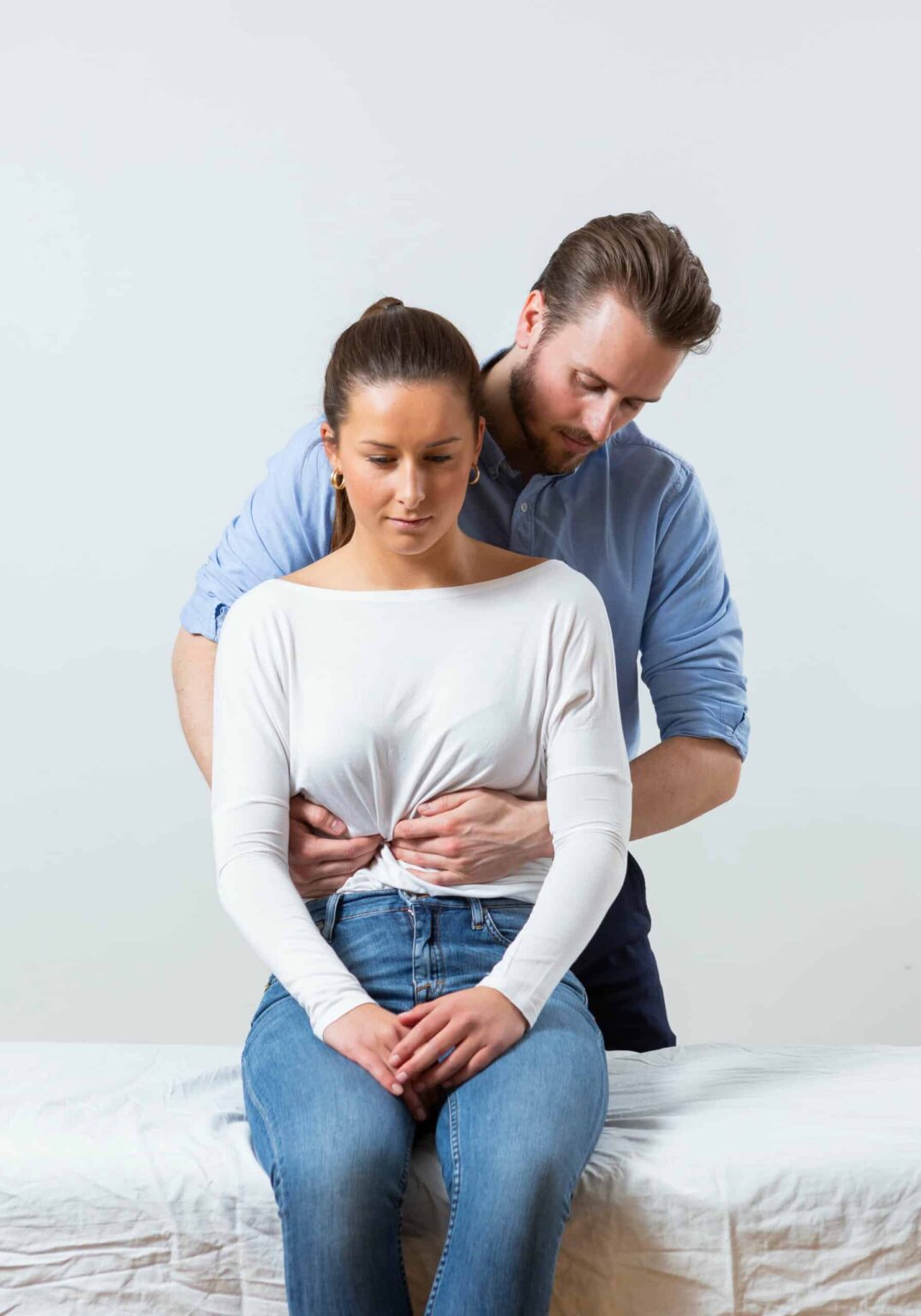
Hidden constipation
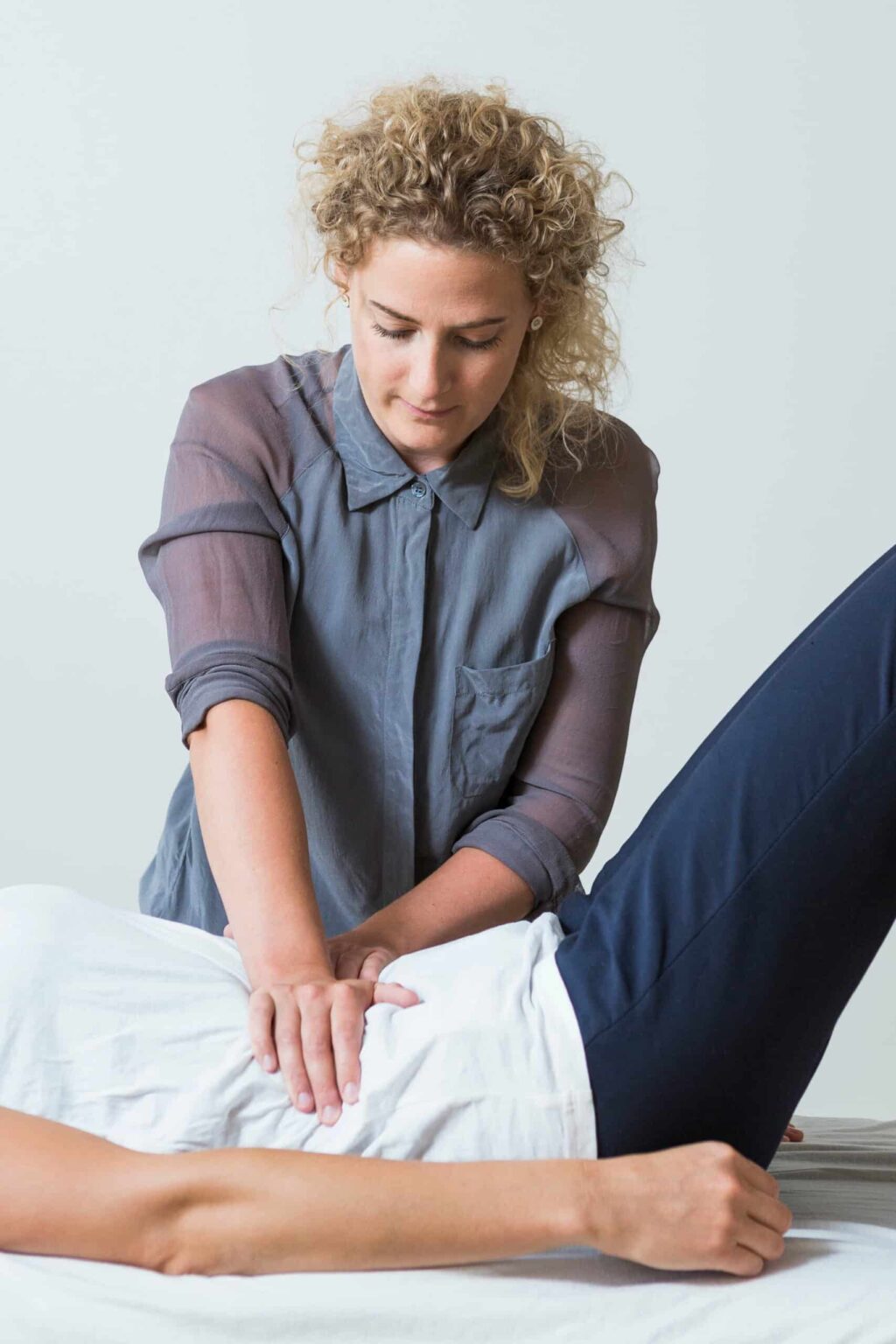
Urinary incontinence
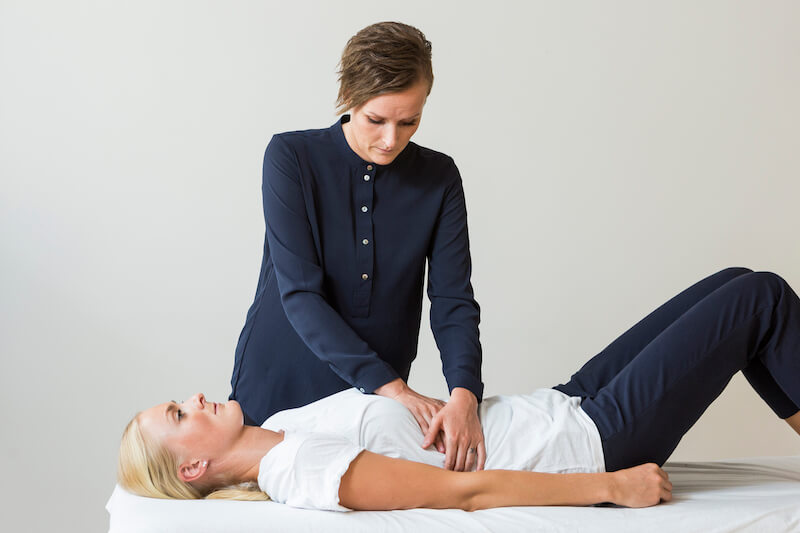
Celiac disease
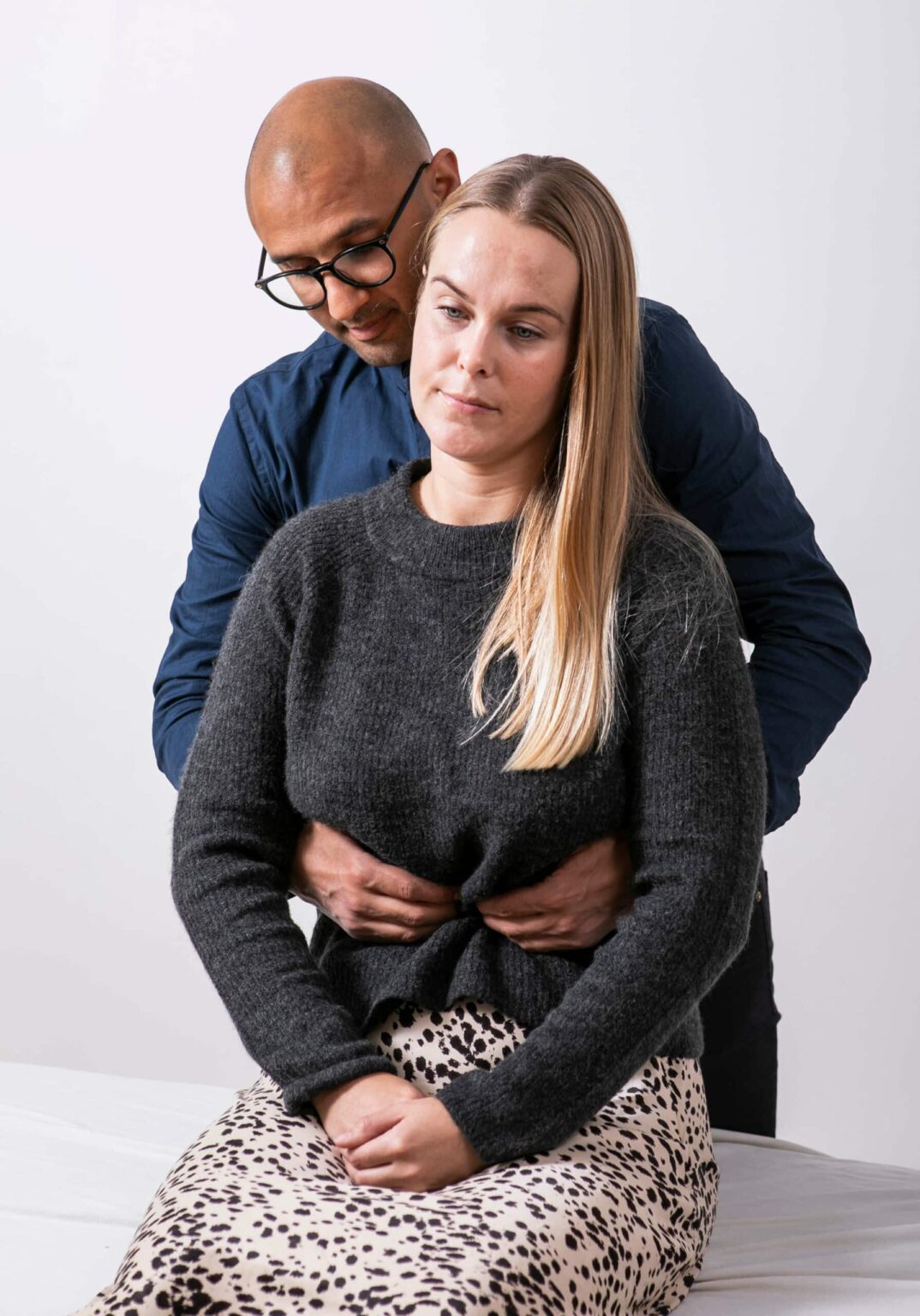
Ulcer

Hernia
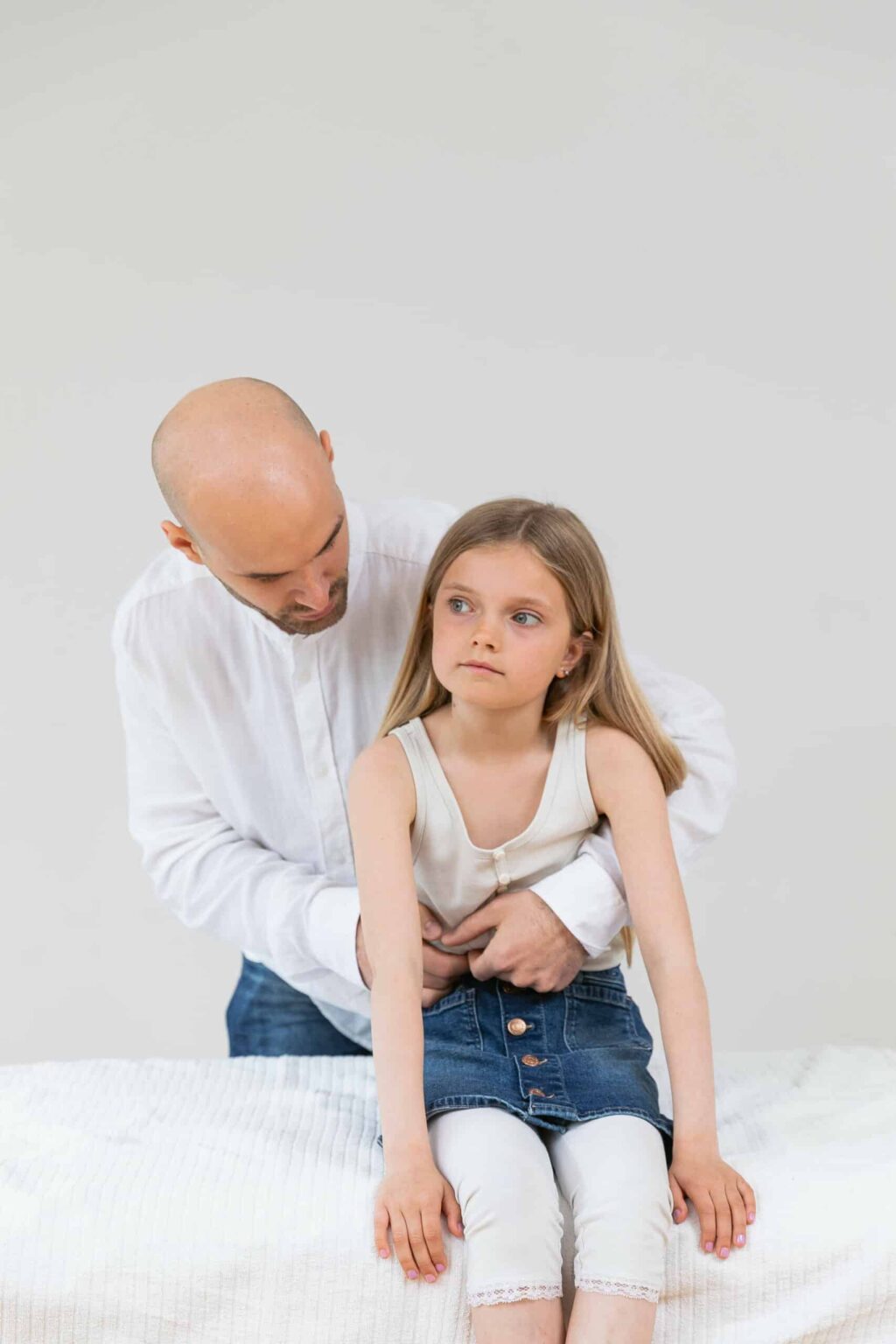
Lactose intolerance

